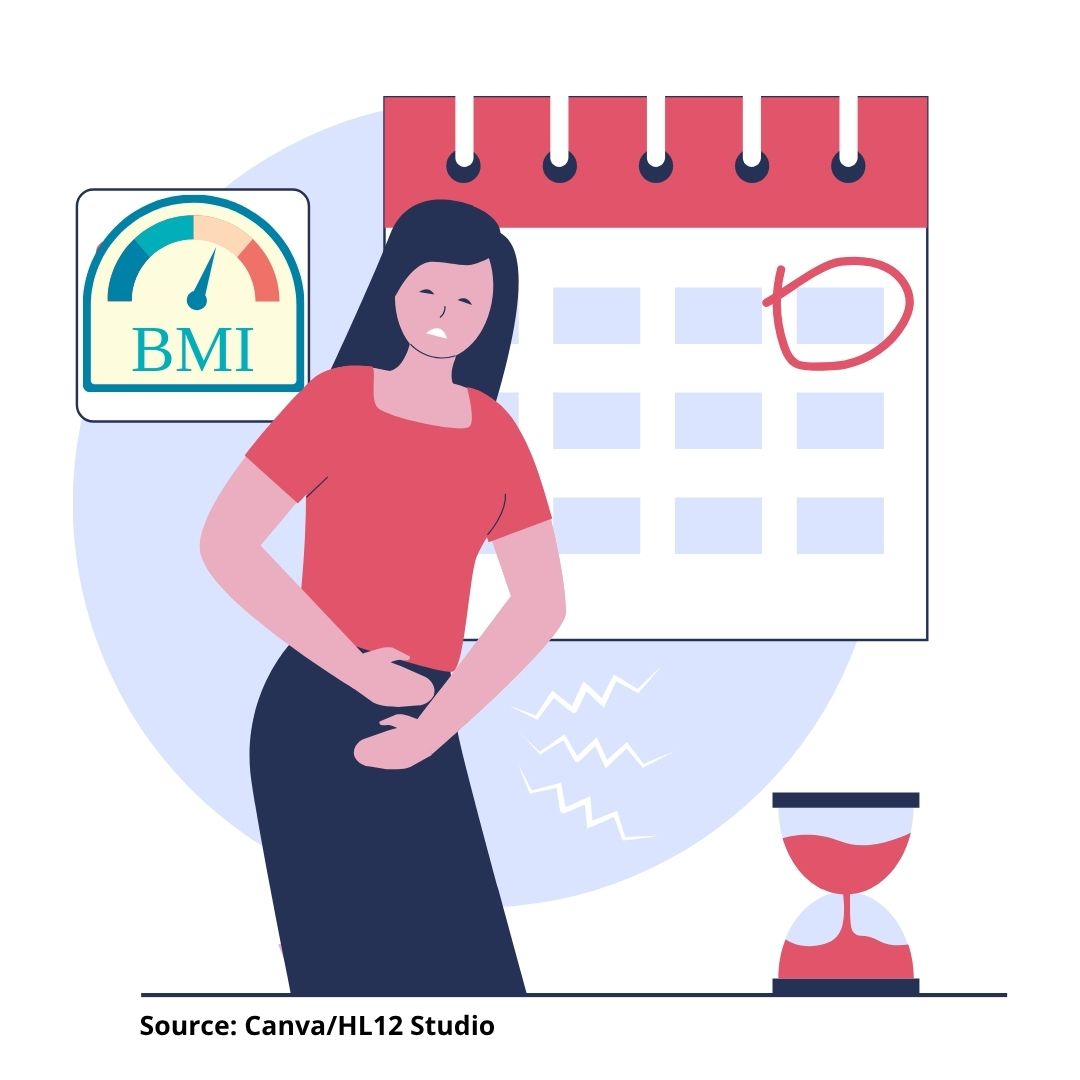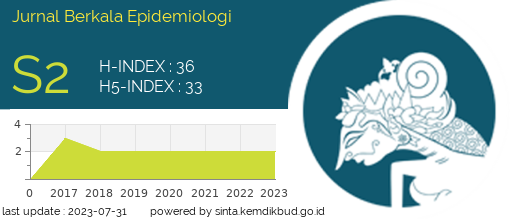THE INFLUENCE OF BODY MASS INDEX ON THE MENSTRUAL CYCLE IN ADOLESCENTS
Pengaruh Indeks Massa Tubuh terhadap Siklus Menstruasi pada Remaja

Downloads
Background: Imbalanced nutritional status in adolescents can affect the menstrual cycle. In 2018, the WHO stated that as many as 80% of women in the world have irregular menstrual cycles. More specifically, this condition is experienced by 11.70% of adolescents aged 15-19 years and 14.90% of women in urban areas. Purpose: To analyze the effect of body mass index (BMI) on the menstrual cycle in adolescents at Junior High School State 19 Surabaya. Methods: This quantitative research employed an observational analytic method with a case-control design at SMP Negeri 19 Surabaya. As many as 104 participants (52 cases with irregular menstrual cycles and 52 controls with regular cycles) were randomly selected in a 1:1 ratio. Data collection occurred from February to May 2024, and bivariate analysis was conducted using the Chi-square test. Results: This study showed that overall BMI had a significant effect on menstrual cycle regularity (p = 0.001). Students with normal BMI have a greater chance of experiencing regular menstruation than overweight/obese (OR = 4.694; 95% CI = 1.536 - 14.344; p = 0.007). Meanwhile, the categories of very thin (OR = 0.985; 95% CI = 0.235 - 4.127; p = 0.983) and underweight (OR = 0.433; 95% CI = 0.072 - 2.622; p = 0.363) did not show a significant influence on menstrual regularity (p > 0.05). Conclusion: Body mass index affects menstrual cycle regularity in adolescents. Maintaining nutritional status is important to minimize the risk of menstrual cycle disorders and ensure reproductive health.
Revi M, Anggraini W, Warji W. Relationship between nutritional status and menstrual cycle in high school students. Cendekia Med J Stikes Al-Maarif Baturaja. 2023;8(1):123–31.
Munisah M. The effect of menarche age on the incidence of menapause in women at Al-Hidayah recitation in Gresik Regency. IJMT Indones J Midwifery Today. 2023;2(2):7–13.
Ilham MA, Islamy N, Nasution SH. Menstrual cycle disorders in adolescents: a literature review. J Penelit Perawat Prof. 2023;5(1):185–92.
Ministry of Health of the Republic of Indonesia. Basic Health Research 2018. Health Research and Development Agency. 2019.
Siagian SA, Irwandi S. The relationship between body mass index and menstrual cycle in medical students of FK UISU. J Kedokt STM (Sains Dan Teknol Med. 2023;6(2):113–20.
Ramadhani N, Rohmah N, Indriyani D. The relationship between sleep duration and menstrual cycle in students of Universitas Muhammadiyah Jember. Med Nutr J Ilmu Kesehat. 2023;1(2):61–70.
Loa WW, Nabuasa E, Sir AB. Relationship between weight, diet, physical activity and stress levels with menstrual cycle disorders. Media Kesehat Masy. 2022;4(1):34–43.
Suleman NAY, Hadju VA, Aulia U. Relationship between nutritional status and menstrual cycle in adolescent girls. Jambura J Epidemiol. 2023;2(2):43–9.
Winengsih E, Fitriani DA, Stelata AG, Sugiharti I. The relationship between physical activity and menstrual cycle in midwifery students at Bhakti Kencana University Bandung. J Nurs Public Heal [Internet]. 2023;11(2):629–35.
Sari FHDK, Puspitadewi TR, Wahyurianto Y. Causing factors of menstrual cycle irrorgy in adolescents at SMAN 4 Tuban. J Ilm Wahana Pendidik. 2024;10(6):322–9.
Wiratni IGA, Thanaya SAP, Tianing IW. Relationship between body mass index and menstrual cycle in adolescents. J Inov Kesehat Terkini [Internet]. 2024;6(2).
Khairunnisa A, Said I, Wikanti CZA. The relationship between diet, physical activity, and menstrual disorders with the nutritional status of adolescent girls at SMAN 1 South Tangerang. Media Gizi Ilm Indones. 2023;1(2):76–84.
Suprapti E, Adriana V, RK MK, Yusfira Y. The relationship between physical activity and body mass index (BMI) with the menstrual cycle in adolescent girls in Balangtaroang village, Bulukumba Regency. J Kesehat Med Udayana. 2022;8(2):222–34.
Gultom MM, Fitriangga A, Ilmiawan MI. Relationship between body mass index and menarche age with menstrual cycle patterns of high school students in Pontianak. Cermin Dunia Kedokt. 2021;48(12):696–9.
Sartika Y, Nugrahmi MA, Febria C. Relationship between body mass index (BMI) and menstrual cycle in seventh grade students at MTSN 3 Agam Nagari Balingka. Innov J Soc Sci Res. 2024;4(1):509–18.
Umi UK, Ali S, Putri AS. Hubungan Indeks Massa Tubuh (IMT) dengan siklus menstruasi pada remaja putri. J Suara Kesehat [Internet]. 2024;10(2).
Pahlawan RG, Manalu LO, Yohana DC. The relationship between body mass index and menstrual cycle in class X adolescent girls at SMAN 1 Cikalong Wetan in 2023. J Online Keperawatan Rajawali [Internet]. 2024;2(1):6–10.
Itriyeva K. The normal menstrual cycle. Curr Probl Pediatr Adolesc Health Care. 2022;52(5):101–83.
Isramilda I, Prihadianto DG. The relationship between body mass index (BMI) and menstrual cycle disorders in Harapan Utama Senior High School students Batam. Zo Kebidanan Progr Stud Kebidanan Univ Batam. 2021;11(2):29–33.
Sagabulang GUK, Telussa AS, Wungouw HPL, Dedy MAE. Relationship between body mass index and menstrual cycle in medical students. Cendana Med J. 2022;10(1):17–23.
Widyaningrum R, Tirtana A. Relationship between nutritional status and menstrual cycle in female students of SMK Gagas Wanareja Cilacap. J Kesehat Madani Med. 2021;12(2):259–65.
Nugrahmi MA. Relationship between body mass index and menstrual disorders. Menara Med. 2020;2(2):81–6.
Wanggy DM, Ulfiana E, Suparmi S. Relationship between nutritional status, diet, physical activity and stress with menstrual cycle disorders. Indones J Midwifery. 2022;5(2):90–101.
- Every manuscript submitted to must observe the policy and terms set by the Jurnal Berkala Epidemiologi
- Publication rights to manuscript content published by the Jurnal Berkala Epidemiologi is owned by the journal with the consent and approval of the author(s) concerned. (download copyright agreement)
- Complete texts of electronically published manuscripts can be accessed free of charge if used for educational and research purposes according to copyright regulations.

JBE by Universitas Airlangga is licensed under a Creative Commons Attribution-ShareAlike 4.0 International License.























